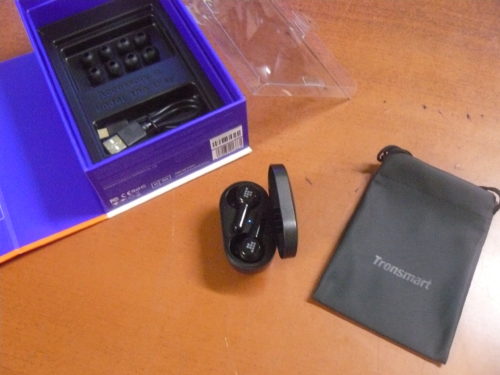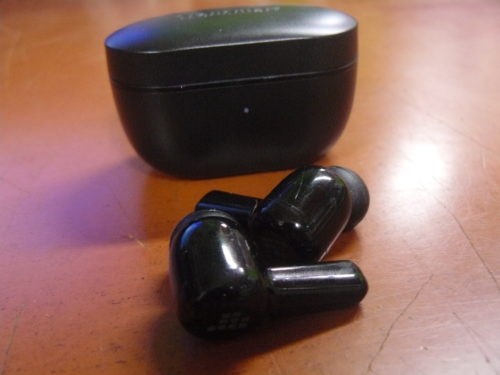When Tronsmart announced their latest true wireless earbud, the Apollo Air, they revealed a second edition to this model. The Apollo Air+ and Apollo Air share a lot of similarities, but the plus version aims to add substantial upgrades to the earphones noise-canceling, accessories, and charging capabilities. They’re priced at a whole thirty dollars more than the Apollo Air. Can these changes be worth the upgrade?

What You Get
- 1 x Apollo Air+
- 1 x Warranty card
- 1 x User manual
- 4 x Extra pair of ear tips
- 1 x Type-C cable
- 1* PU bag
Here you can see Tronsmart has offered an extra pair of ear tips, which is always welcome. They’ve also supplied a new drawstring carrying bag for the earbuds and charging case. You don’t see that often, but it’s good for when your pockets are full. The entire box is also noticeably bigger, inferring more accessories inside.
Look and Feel
You can expect the same type of look from the Apollo Air for the Apollo Air+. If you weren’t a fan of the previous model’s plastic shell design, you probably won’t be a fan of its return here. It didn’t bother me quite as much in my original review mainly due to how light they were, and that can be repeated here. That means the fit is mostly going to be the same too, featuring a comfortable fit that feels almost invisible.

Design and Functionality
The Apollo Air and Air plus share many similar features with a few key differences. You’ll find the same 10mm graphene dynamic driver within the Apollo Air+, along with the same three mics in each earphone. The earbuds produce a good level of amplitude with plenty of headroom for gain. I was a fan of how quickly the actions respond to the touch sensitive interface. Each action, whether that be volume, play/pause, or cycling through ambient and noise-canceling modes, the touch response is always immediate with little to no delay.
The controls are also completely customizable if you download the companion app, which I got to actually use this time. For some reason I always failed to connect the Apollo Air to the app on my phone, but with the plus version I was able to connect a lot more easily. Here you can switch up the controls, activate noise-canceling and ambient modes, and choose between a selection of EQ presets. You’ll see options like “deep bass,” “classical,” “rock,” and a few others. Although these are great features, I still had a few issues concerning the app.
My major gripe is that the app isn’t accurate when telling you how much battery life you have left. Both my earbuds displayed almost full charge before the voice assistant notified me that I had low battery. Lastly I’ll mention the noise-canceling which I thought was a bit improved here. I wasn’t sure how different both models were, but It might be the case of it growing on me. It still has issues with high frequency noise, but most of the ambience is completely gone otherwise.
Bluetooth
Heavy advertising for the Apollo Air and Apollo Air+ focused on the earbuds Qualcomm QCC 3040 chipset. With it you get a clear streaming resolution through an aptX CODEC, in addition to the quality support through Bluetooth 5.2.
Battery Life
Same as the Apollo Air, you’ll get five hours of playtime off a single charge, and a total of 20 hours when you include the charging case.
Soundstage
Like the previous Apollo Air, the Air+ provides some great clarity for the price increased by the imaging and separation. It’s an impressive amount of separation for a true wireless, and the positioning within the stereo field is quite accurate. You won’t find much depth here, but the imaging has consistent layering for better articulation. Nothing about it blew my mind, mostly because it was similar to what I already heard from the Apollo Air, but it still makes a good impression once again.
Low End
The bass here is as strong as the Apollo Air, and not much different. You get a nice full bass response that makes a great impact on the sound signature. The thumpy timbre is great of certain genres, but can be a little overbearing for others. Using the app can reduce the bass tonality a little, but it loses some fidelity in response, revealing a weaker textural output.
Mids
You’ll be satisfied if you’re a fan of v-shaped sound signatures with good vocal response, but not much else. Some of the low mids are just too overpowering for much clarity in the midrange, but certain elements can break through well. At its best the timbre can come off as properly natural, but are bogged down with tonal imbalances.
Highs
Both Apollo Air’s have the same brighter treble, with some piercing bands of frequency that might turn some listeners off. However it was these elements that brought the sound signature out of a dull tone, and up to something a bit more interesting. It made the timbre of the highs much more engaging, and helped me immerse myself more into its sound. They’re surprisingly clear, and make the earphones more versatile in genre.
Summary
If you’re mostly concerned about being able to charge wirelessly, then this might be one of the only reasons to spend the extra cash of the plus version. Otherwise, there are no discernible improvements to sound quality, which would have made them more worthwhile. The app brings a lot of good customization options, but that’s only if you can get it to work properly, which isn’t a given unfortunately. Noise-canceling seems to have improved, but not by much. Overall, if I had a choice I would probably stick with the regular Apollo Air earbuds, as the plus adds little to justify the jump in price.
Pros and Cons
Pros:
- Wireless charging
- Improved noise-cancelling
- More accessories
- Same punchy bass as the Apollo Air
Cons:
- Doesn’t offer much to justify the jump in price
- Finicky app
You can find the Tronsmart Apollo Air+ on their website here.
Compare the ranking of various headphones, earbuds and in-ear monitors using our tools.
Discuss this, and much more, over on our forum.
---MAJORHIFI may receive commissions from retail offers.















